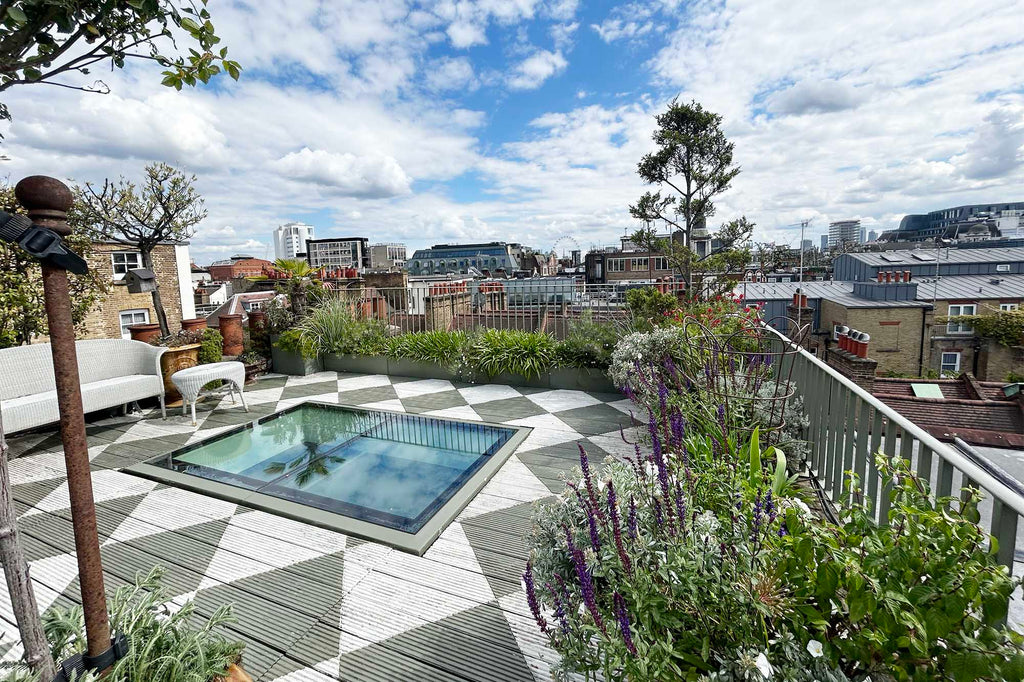Secret Gardeners: Tiggy Maconochie’s Soho Garden in the Sky
Posted by SECRET GARDENER

Name: Tiggy Maconochie
Profession: Photographic Agent
From Soho streets, a treat to ascend to a tranquil garden in the sky. Tiggy’s garden looks over four centuries of London, from Canary Wharf to the Palace of Westminster.
Tiggy’s Soho flat is built across multiple levels of plunging staircases, stylish modernism injected into Georgian architecture. The garden sits on a flat roof with large central skylight appearing like a glass plunge pool. Tiggy painted the decking checkerboard style, with olive planters that run round the edge, filled with silvery, white hues.

The planters teem with flowers, many reseeded. Completely exposed to the elements with year-round sunshine, many plants are Mediterranean as they do well. The large mustard-coloured Madelaine Uze pots that frame the seating areas, are from the South of France. The garden is framed by listed Georgian terracotta chimney pots, all signed by their makers, one ringed with distinctive thistle design.


We discuss three gardens across Soho, Uruguay, and Dungeness, Tiggy’s soon to be seaside garden on the Kent/Sussex border.
SFG: Where is the garden located?
TM: On an eighteenth-century building, it’s changed but that's what gardeners do, they evolve, not everything went up there straightaway, it took time.
Arching over white wicker seating is jasmine, which Tiggy is training to join up with the olive trees for more flowers, and better for birds.
TM: Sometimes there's hundreds of little birds up there, sheltering before moving on.


On Wildlife Corridors.
TM: I plant for invertebrates and birds, finches, bluetits, blackbirds, the odd Robin. I have seen Dunnocks, even a wren.
A duck flew in and built a nest, Tiggy sought advice from one of the park keepers in St Jame’s Park and once hatched the ducklings were rounded up, just in time, tumbling down drainpipes, chasing down Meard street. They joined a clutch of recently hatched ducklings in St James,’ their mother having flown off.
TM: I have this big, fat wood pigeon I call Percy who quite likes the sofa. London is full of wildlife, this garden, and others, act as wildlife corridors.

SFG: What garden tool you use most?
TM: Gardening gloves, and my snips Edwardian design. I love Trugs they are my garden office, you put everything in them and don’t have to keep walking forwards and backwards.
SFG: Which is your favourite plant?
TM: There are so many in this garden; Santolina, Iris, Trailing Rosemary (flowers often, through year), Achillea, Dianthus, Erigeron, Allium (various), English Lavender, Arithium, Salvias (various), Roses (various) Pelargoniums, Honey Suckle, Olive Trees, Nerine Sarniens, Hesparanthen, Agapanthus, Sage, Thyme and Persicaria.
SFG: Urban gardening can be a challenge with space. How have you maximised your garden?
TM: I've got a lot of Mediterranean plants including these large olive trees, evergreen is important as you don’t want lots of leaves blocking all the gutters, making a garden is a combination of creativity, desire discovery and certain amount of science. Some things work, some things don't, I think it's important not to be afraid.

Tiggy represented German-Australian fashion photographer Helmut Newton, dubbed the “King of Kink” for over 20 years
SFG: You’ve had a creative career in fashion and photography, is this reflected in your garden?
TM: No, I don’t think so, my grandmother was a gardener, and very into nature. I think, that always interested me, but it's not something I really did until much later on in my life. I was part of the photography review in the mid 80s and I started to represent some of the most important and dynamic, fashion photographers from the 20th into the 21st century. This was the first real garden I really created from scratch, but the more intrepid garden is out in Uruguay because people don't garden generally so it's difficult to get plants. The climate and insects are different.

SFG: What does your garden mean to you?
TM: It connects me to nature in the middle of London, it makes me go outside, a different way to connect than being on the street because you get a really good position of where you are, it's just a delight it's always a surprise going up.
SFG: How does this garden survive being so exposed?
TM: Our summers can be very dry. I have a drip system that is serviced once a year, because bits need replacing and hard water in London corrodes and birds pick it particularly in the spring. Most people think an irrigation system means you don't need to water but you do. You should be in the garden, year round enjoying it, working throughout the whole year in the autumn October, you get wonderful days when you can be up on the roof.

SFG: Tell us more about your next garden in Dungeness
TM: There is a small garden at the back. I'm really looking forward to creating a seaside garden it's sheltered because the front looks right over the Straits of Dover so bit windy and salty. I'm going to Beth Chatto’s Garden, and I've already ordered some Cedric Morris Iris.
SFG: When you started developing your garden in Uruguay did that start a trend?
TM: My neighbour had a garden, she very sadly died last year, and it was beautiful. I've learned how I companion plant so different plants protect each other. I use certain plants as repellents, I try not to use any nasties. First thing in the morning, I go out and kill 100 snails. And then I leave them to the birds. I'm not putting down nasty poisons. I've taught people how to weed, pull them up by the roots because otherwise you're promoting that weed to grow faster.
TM: In Uruguay I am constantly trying to talk to my team about pesticides, they say isn't it quick and I say no it's not just going to kill the weeds, you poison all the earth around, it’s going to go down into the ground, wash into and contaminate the rivers. and the animals that we eat. So, a cycle, contaminate the environment and eventually it will contaminate us. But that is a very big story.

New owners, Tiggy has sold up. She will leave a folder with everything from the irrigation system to lists of all the plants, pots and furniture.
SFG: What’s next for your space?
TM: You are passing on this legacy and to think that it's an 18th century building, and I've still got those views intact.

